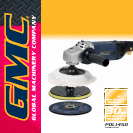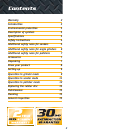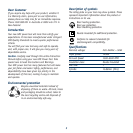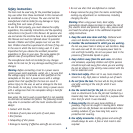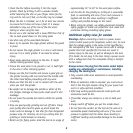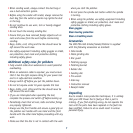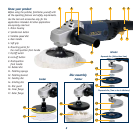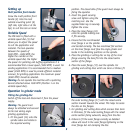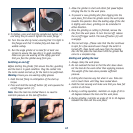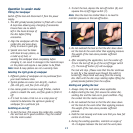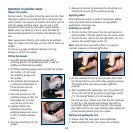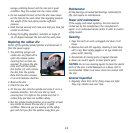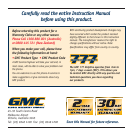
6
• Check the disc before mounting it into the angle
grinder. Check by striking it with a wooden handle
whilst balancing the disc on your finger. Listen for the
ring and do not use if dull, as the disc may be cracked.
• When the disc is installed, run it for at least one minute
to ensure that it does not have a fault. It is always
advisable to stay out of the line of the disc when
testing or when using the tool.
• Do not use a disc marked with a lower RPM than that of
the no load speed shown on the rating plate.
• Use discs only of the prescribed diameter.
• Never try to operate the angle grinder without the guard
in place.
• Do not secure the angle grinder in a vice or work bench
and use it as a static grinder. It can lead to serious
injury.
• Never apply excessive pressure to the disc. It might
shatter causing personal injury.
• Ensure the work piece to be ground or cut, is held tight
in the vice or other clamping system.
• Always use the front handle and ensure a good grip on
the grinder housing with one hand and the handle with
the other hand before proceeding with any work.
• Make sure that the disc is not in contact with the work
when you start the grinder.
• Be careful not to damage the spindle or either of the
disc flanges. Damage to these parts could result in disc
breakage.
• Do not press the spindle lock button whilst the spindle
is turning.
• Only use good quality grinding and cut off discs. Cheap
poor quality discs tend to glaze up which loads the
motor and can damage it. Use discs for their designated
purpose only. For instance, do not use cutting discs for
grinding or metal wheels on masonry.
• Watch out for flying sparks. Hold the tool at an angle of
approximately 15º to 30º to the work piece surface.
• Let the disc do the grinding or cutting at a reasonable
feed, as overloading will occur if too much pressure is
applied and the disc slows resulting in inefficient
cutting and possible damage to the motor.
• When using the grinder, use safety equipment including
safety goggles or shield, ear protection, dust mask and
protective clothing including safety gloves.
Additional safety rules for sanders
Warnings. Before connecting a tool to a power source
(mains switch power point receptacle, outlet, etc.) be sure
that the voltage supply is the same as that specified on
the nameplate of the tool. A power source with a voltage
greater than that specified for the tool can result in
serious injury to the user, as well as damage to the tool.
If in doubt, do not plug in the tool. Using a power source
with a voltage less than the nameplate rating is harmful
to the motor.
Always remove the plug from the mains socket before
making any adjustments or maintenance, including
changing the sanding belt.
• Fully unwind cable drum extensions to avoid potential
overheating.
• When an extension cable is required, you must ensure
that it has the right ampere rating for your power tool
and is in safe electrical condition.
• After long working periods external metal parts and
accessories could be hot.
• If possible, always use clamps or a vice to hold your
work.
• Always switch off before you put the sander down.
• Do not force the sander; let the tool do the work at a
reasonable speed. Overloading will occur if too much
pressure is applied and the motor slows resulting in
inefficient sanding and possible damage to the sander
motor.



